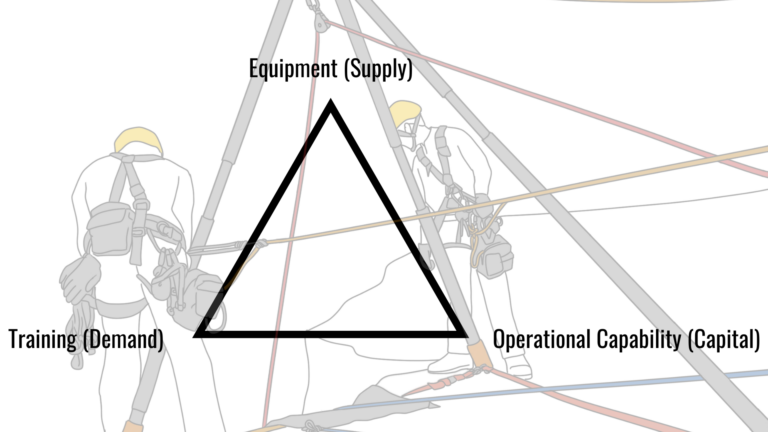In both business and rope rescue operations, understanding the underlying forces and dynamics can profoundly affect outcomes. Typically, rescue systems are viewed through a purely technical lens—focusing on equipment and procedures. However, by adopting a business-like framework that integrates concepts similar to supply, demand, and capital, we can gain a fresh perspective that enhances our strategic planning and execution in rescue missions. This article introduces a new way to conceptualize rope rescue operations, borrowing from the business world to challenge traditional approaches and enhance effectiveness.
The New Triad for Rope Rescue:
- Equipment – The Supply of Rope Rescue
- Just as businesses need products to operate, rope rescue requires specific tools and gear.
- Ensuring availability and proper maintenance of equipment like ropes, harnesses, and pulleys is crucial.
- Training – The Demand in Rope Rescue
- Demand here isn’t about consumer needs but the necessity for skilled, well-prepared rescue personnel.
- Continuous training is essential to meet the evolving challenges and ensure safety and efficiency on every mission.
- Operational Capability – The Capital of Rope Rescue
- This encompasses the support structures that enable effective rescues: funding, logistics, and administrative backing.
- Just as capital in business drives growth, robust support ensures that rescue operations can be carried out effectively.
The Interplay:
- Interdependence: Just like in business, each element of the triad supports and enhances the others. Without strong training, even the best equipment can be underutilized.
- Balanced Investment: Resources must be balanced across all three aspects to optimize response capabilities and mission success.
- Dynamic Adjustment: Respond to changing conditions by adapting strategies in training, equipment upgrades, and resource allocation, much like businesses adjust to market dynamics.
Adopting a business-like framework to view rope rescue operations opens up new avenues for innovation and efficiency. By seeing equipment as our supply, training as our demand, and operational capability as our capital, we can create a balanced and responsive approach that ensures both safety and effectiveness. This perspective invites us to think differently, plan strategically, and deploy our resources in a way that maximizes the impact of every rescue operation.
Challenge the conventional wisdom of your current rope rescue practices. Consider this new triad as a lens to examine your operations. Where can you balance your ‘supply’, increase your ‘demand’, and enhance your ‘capital’ to improve overall effectiveness? Engage with us in a workshop to explore these concepts further and revolutionize your approach to rope rescue.
This article aims to provoke thought and inspire a paradigm shift among firefighters and SAR members, encouraging them to view their critical work through a new, strategic lens that not only enhances their operational capabilities but also potentially saves more lives with greater efficiency.
Integrating business principles like supply, demand, and capital into rope rescue can streamline operations and improve resource use. This method has potential advantages and disadvantages, with varying impacts on different stakeholders.
Benefits:
- Enhanced Efficiency: Organizing rescue operations like a business can help make them more systematic and quick, ensuring teams are ready and equipped when emergencies occur.
- Better Resource Management: Looking at operations through a business lens helps ensure that money and resources are used where they are most needed, potentially increasing support from funders.
- Continuous Improvement: Adopting business strategies for ongoing assessment and adjustment keeps rescue operations up-to-date and effective.
Drawbacks:
- Over-Complication: Some argue that this approach makes simple rescue operations too complex and bureaucratic.
- Misalignment with Core Values: There’s a concern that focusing on business efficiency could shift focus from the primary goal of saving lives.
- Resistance to Change: Established rescue operations might resist adopting a new framework, fearing it could disrupt current practices.
Who Benefits?
- Administration: Leaders and managers benefit most as they gain tools for better planning, funding justification, and operation scaling.
- Rope Technicians: Indirectly benefit through consistent access to modern equipment and updated training, enhancing safety and job performance.
Conclusion:
Adopting a business framework in rope rescue could lead to more efficient and responsive operations but must be implemented thoughtfully to avoid complicating processes or diluting mission focus. Success depends on clear communication and alignment with the essential values and needs of rescue teams.
This streamlined version focuses on the core ideas and implications of applying business strategies to rope rescue, aiming to make the concept accessible and relevant to both administrators and frontline rescue personnel.
Peace on your Days
Lance









